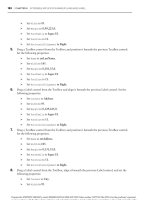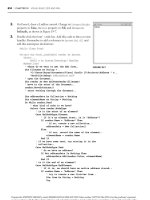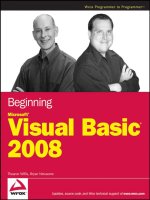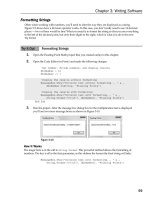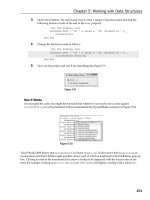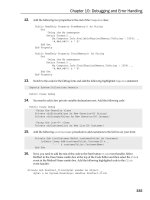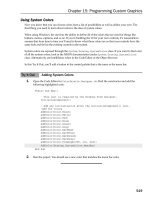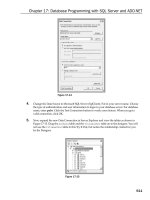Beginning Microsoft Visual C# 2008 PHẦN 4 pot
Bạn đang xem bản rút gọn của tài liệu. Xem và tải ngay bản đầy đủ của tài liệu tại đây (1.43 MB, 135 trang )
Chapter 12: Generics
369
4. What is wrong with the following code? Fix it.
public class StringGetter < T >
{
public string GetString < T > (T item)
{
return item.ToString();
}
}
5. Create a generic class called ShortCollection < T > that implements IList < T > and consists of a
collection of items with a maximum size. This maximum size should be an integer that can be
supplied to the constructor of
ShortCollection < T > or defaults to 10. The constructor should
also be able to take an initial list of items via a
List < T > parameter. The class should function
exactly like Collection < T > but throw an exception of type IndexOutOfRangeException if
an attempt is made to add too many items to the collection, or if the
List < T > passed to the
constructor contains too many items.
c12.indd 369c12.indd 369 3/24/08 4:23:58 PM3/24/08 4:23:58 PM
c12.indd 370c12.indd 370 3/24/08 4:23:59 PM3/24/08 4:23:59 PM
13
Additional OOP Techniques
In this chapter, you continue exploring the C# language by looking at a few bits and pieces that
haven ’ t quite fit in elsewhere. This isn ’ t to say that these techniques aren ’ t useful — just that they
don ’ t fall under any of the headings you ’ ve worked through so far.
Specifically, you will look at the following:
The
:: operator and the global namespace qualifier
Custom exceptions and exception recommendations
Events
Anonymous methods
You also make some final modifications to the CardLib code that you ’ ve been building in the last
few chapters, and even use CardLib to create a card game.
The :: Operator and the Global
Namespace Qualifier
The :: operator provides an alternative way to access types in namespaces. This may be necessary
if you want to use a namespace alias and there is ambiguity between the alias and the actual
namespace hierarchy. If that ’ s the case, then the namespace hierarchy is given priority over
the namespace alias. To see what this means, consider the following code:
using MyNamespaceAlias = MyRootNamespace.MyNestedNamespace;
namespace MyRootNamespace
{
namespace MyNamespaceAlias
{
❑
❑
❑
❑
c13.indd 371c13.indd 371 3/24/08 3:46:46 PM3/24/08 3:46:46 PM
372
Part I: The C# Language
public class MyClass
{
}
}
namespace MyNestedNamespace
{
public class MyClass
{
}
}
}
Code in
MyRootNamespace might use the following to refer to a class:
MyNamespaceAlias.MyClass
The class referred to by this code is the MyRootNamespace.MyNamespaceAlias.MyClass class,
not the
MyRootNamespace.MyNestedNamespace.MyClass class. That is, the namespace
MyRootNamespace.MyNamespaceAlias has hidden the alias defined by the using statement, which
refers to
MyRootNamespace.MyNestedNamespace . You can still access the MyRootNamespace
.MyNestedNamespace
namespace and the class contained within, but you require different syntax:
MyNestedNamespace.MyClass
Alternatively, you can use the :: operator:
MyNamespaceAlias::MyClass
Using this operator forces the compiler to use the alias defined by the using statement, and therefore the
code refers to
MyRootNamespace.MyNestedNamespace.MyClass .
You can also use the keyword
global with the :: operator, which is essentially an alias to the top - level,
root namespace. This can be useful to make it clearer which namespace you are referring to, as shown here:
global::System.Collections.Generic.List < int >
This is the class you’d expect it to be, the generic List < T > collection class. It definitely isn ’ t the class
defined with the following code:
namespace MyRootNamespace
{
namespace System
{
namespace Collections
{
c13.indd 372c13.indd 372 3/24/08 3:46:47 PM3/24/08 3:46:47 PM
373
Chapter 13: Additional OOP Techniques
namespace Generic
{
class List < T >
{
}
}
}
}
}
Of course, you should avoid giving your namespaces names that already exist as .NET namespaces,
although this problem may arise in large projects, particularly if you are working as part of a large team.
Using the
:: operator and the global keyword may be the only way you can access the types you want.
Custom Exceptions
Chapter 7 covered exceptions and explained how you can use try catch finally blocks to act
on them. You also saw several standard .NET exceptions, including the base class for exceptions,
System.Exception . Sometimes it ’ s useful to derive your own exception classes from this base class for
use in your applications, instead of using the standard exceptions. This enables you to be more specific
with the information you send to whatever code catches the exception, and it enables catching code
to be more specific about which exceptions it handles. For example, you might add a new property to
your exception class that permits access to some underlying information, making it possible for
the exception ’ s receiver to make the required changes, or just provide more information about the
exception ’ s cause.
Once you have defined an exception class, you can add it to the list of exceptions recognized by VS using
the Debug
Exceptions dialog ’ s Add button, and then define exception - specific behavior as shown in
Chapter 7 .
Exception Base Classes
While you can derive exceptions from System.Exception as described in the previous section, best
practices dictate that you don ’ t. Instead, you should derive custom exceptions from
System
.ApplicationException
.
Two fundamental exception classes exist in the
System namespace and derive from Exception :
ApplicationException and SystemException . SystemException is used as the base class for
exceptions that are predefined by the .NET Framework.
ApplicationException is provided for
developers to derive their own exception classes. If you follow this model, then you will always be able
to differentiate between predefined and custom exceptions by catching exceptions that derive from one
of these two base classes.
Neither
ApplicationException nor SystemException extend the functionality of the Exception
class in any way. They exist purely so that you can differentiate between exceptions in the manner
described here.
c13.indd 373c13.indd 373 3/24/08 3:46:47 PM3/24/08 3:46:47 PM
374
Part I: The C# Language
Adding Custom Exceptions to CardLib
How to use custom exceptions is, once again, best illustrated by upgrading the CardLib project. The
Deck.GetCard() method currently throws a standard .NET exception if an attempt is made to access a
card with an index less than 0 or greater than 51, but you ’ ll modify that to use a custom exception.
First, you need to create a new class library project called Ch13CardLib and copy the classes from
Ch12CardLib as before, changing the namespace to Ch13CardLib as applicable. Next, define the
exception. You do this with a new class defined in a new class file called
CardOutOfRangeException
.cs
, which you can add to the Ch13CardLib project with Project Add Class:
public class CardOutOfRangeException : ApplicationException
{
private Cards deckContents;
public Cards DeckContents
{
get
{
return deckContents;
}
}
public CardOutOfRangeException(Cards sourceDeckContents) :
base(“There are only 52 cards in the deck.”)
{
deckContents = sourceDeckContents;
}
}
An instance of the Cards class is required for the constructor of this class. It allows access to this Cards
object through a
DeckContents property and supplies a suitable error message to the base Exception
constructor, so that it is available through the
Message property of the class.
Next, add code to throw this exception to
Deck.cs (replacing the old standard exception):
public Card GetCard(int cardNum)
{
if (cardNum > = 0 & & cardNum < = 51)
return cards[cardNum];
else
throw new CardOutOfRangeException(cards.Clone() as Cards);
}
The DeckContents property is initialized with a deep copy of the current contents of the Deck object,
in the form of a
Cards object. This means that you see what the contents were at the point where the
exception was thrown, so subsequent modification to the deck contents won ’ t “ lose ” this information.
c13.indd 374c13.indd 374 3/24/08 3:46:47 PM3/24/08 3:46:47 PM
375
Chapter 13: Additional OOP Techniques
To test this, use the following client code (in Ch13CardClient in the downloadable code for this chapter):
Deck deck1 = new Deck();
try
{
Card myCard = deck1.GetCard(60);
}
catch (CardOutOfRangeException e)
{
Console.WriteLine(e.Message);
Console.WriteLine(e.DeckContents[0]);
}
Console.ReadKey();
This code results in the output shown in Figure 13 - 1 .
Figure 13-1
Here, the catching code has written the exception
Message property to the screen. You also displayed the
first card in the
Cards object obtained through DeckContents , just to prove that you can access the
Cards collection through your custom exception object.
Events
This section covers one of the most frequently used OOP techniques in .NET: events . You start, as usual,
with the basics — looking at what events actually are. After that, you ’ ll see some simple events in action
and learn what you can do with them. Then you learn how you can create and use events of your own.
At the end of this chapter you ’ ll complete your CardLib class library by adding an event. Finally, because
this is the last port of call before arriving at some advanced topics, you ’ ll have a bit of fun creating a card
game application that uses this class library.
What Is an Event?
Events are similar to exceptions in that they are raised (thrown) by objects, and you can supply code that
acts on them. However, there are several important differences, the most important of which is that there
is no equivalent to the
try catch structure for handling events. Instead, you must subscribe to them.
Subscribing to an event means supplying code that will be executed when an event is raised, in the form
of an event handler .
c13.indd 375c13.indd 375 3/24/08 3:46:48 PM3/24/08 3:46:48 PM
376
Part I: The C# Language
Many handlers can be subscribed to an event, all of which are called when the event is raised. This may
include event handlers that are part of the class of the object that raises the event, but event handlers are
just as likely to be found in other classes.
Event handlers themselves are simply functions. The only restriction on an event handler function is that
it must match the return type and parameters required by the event. This restriction is part of the
definition of an event and is specified by a delegate .
The fact that delegates are used in events is what makes delegates so useful. This is why some space was
devoted to them in Chapter 6 . You may want to review that material to refresh your memory about
delegates and how you use them.
The basic sequence of processing is as follows: First, an application creates an object that can raise an
event. For example, suppose an instant messaging application creates an object that represents a
connection to a remote user. That connection object might raise an event when a message arrives through
the connection from the remote user (see Figure 13 - 2 ).
Application Connection
Creates
Figure 13-2
Next, the application subscribes to the event. Your instant messaging application would do this by
defining a function that could be used with the delegate type specified by the event, passing a reference
to this function to the event. The event handler function might be a method on another object, such as an
object representing a display device to display instant messages when they arrive (see Figure 13 - 3 ).
Application
Display
Connection
Subscribes to
Creates
Figure 13-3
When the event is raised, the subscriber is notified. When an instant message arrives through the
connection object, the event handler method on the display device object is called. Because you are using
a standard method, the object that raises the event may pass any relevant information via parameters,
making events very versatile. In the example case, one parameter might be the text of the instant message,
which the event handler could display on the display device object. This is shown in Figure 13 - 4 .
c13.indd 376c13.indd 376 3/24/08 3:46:48 PM3/24/08 3:46:48 PM
377
Chapter 13: Additional OOP Techniques
Application
Display
Connection
Calls
Raises Event
Hi Mum
Figure 13-4
Handling Events
As previously discussed, to handle an event you need to subscribe to it by providing an event handler
function whose return type and parameters match that of the delegate specified for use with the event.
The following example uses a simple timer object to raise events, which results in a handler function
being called.
Try It Out Handling Events
1.
Create a new console application called Ch13Ex01 and save it in the directory
C:\BegVCSharp\Chapter13.
2. Modify the code in Program.cs as follows:
using System;
using System.Collections.Generic;
using System.Linq;
using System.Text;
using System.Timers;
namespace Ch13Ex01
{
class Program
{
static int counter = 0;
static string displayString =
“This string will appear one letter at a time. “;
static void Main(string[] args)
c13.indd 377c13.indd 377 3/24/08 3:46:49 PM3/24/08 3:46:49 PM
378
Part I: The C# Language
{
Timer myTimer = new Timer(100);
myTimer.Elapsed += new ElapsedEventHandler(WriteChar);
myTimer.Start();
Console.ReadKey();
}
static void WriteChar(object source, ElapsedEventArgs e)
{
Console.Write(displayString[counter++ % displayString.Length]);
}
}
}
3. Run the application (once it is running, pressing a key will terminate the application). The
result, after a short period, is shown in Figure 13 - 5 .
Figure 13-5
How It Works
The object you are using to raise events is an instance of the System.Timers.Timer class. This object
is initialized with a time period (in milliseconds). When the
Timer object is started using its
Start() method, a stream of events is raised, spaced out in time according to the specified time
period.
Main() initializes a Timer object with a timer period of 100 milliseconds, so it will raise events
10 times a second when started:
static void Main(string[] args)
{
Timer myTimer = new Timer(100);
The Timer object possesses an event called Elapsed , and the event handler required by this event
must match the return type and parameters of the
System.Timers.ElapsedEventHandler delegate
type, which is one of the standard delegates defined in the .NET Framework. This delegate specifies
the following return type and parameters:
void functionName(object source, ElapsedEventArgs e);
The Timer object sends a reference to itself in the first parameter and an instance of an
ElapsedEventArgs object in its second parameter. It is safe to ignore these parameters for now; you ’ ll
take a look at them a little later.
c13.indd 378c13.indd 378 3/24/08 3:46:49 PM3/24/08 3:46:49 PM
379
Chapter 13: Additional OOP Techniques
In your code you have a suitable method:
static void WriteChar(object source, ElapsedEventArgs e)
{
Console.Write(displayString[counter++ % displayString.Length]);
}
This method uses the two static fields of Class1 , counter and displayString , to display a single
character. Every time the method is called the character displayed is different.
The next task is to hook this handler up to the event — to subscribe to it. To do this, you use the
+=
operator to add a handler to the event in the form of a new delegate instance initialized with your
event handler method:
static void Main(string[] args)
{
Timer myTimer = new Timer(100);
myTimer.Elapsed += new ElapsedEventHandler(WriteChar);
This command (which uses slightly strange - looking syntax, specific to delegates) adds a handler to the list
that will be called when the
Elapsed event is raised. You can add as many handlers as you like to
this list as long as they all meet the criteria required. Each handler is called in turn when the event is raised.
All that remains for
Main() to do is to start the timer running:
myTimer.Start();
You don ’ t want the application terminating before you have handled any events, so you put the
Main() function on hold. The simplest way to do this is to request user input, as this command won ’ t
finish processing until the user has pressed a key:
Console.ReadKey();
Although processing in Main() effectively ceases here, processing in the Timer object continues. When
it raises events it calls the
WriteChar() method, which runs concurrently with the Console
.ReadLine()
statement.
Defining Events
Now it ’ s time to define and use your own events. The following Try It Out implements an example
version of the instant messaging scenario introduced earlier in this chapter, creating a
Connection
object that raises events that are handled by a
Display object.
c13.indd 379c13.indd 379 3/24/08 3:46:49 PM3/24/08 3:46:49 PM
380
Part I: The C# Language
Try It Out Defi ning Events
1.
Create a new console application called Ch13Ex02 and save it in the directory
C:\BegVCSharp\Chapter13.
2. Add a new class called Connection and modify Connection.cs as follows:
using System;
using System.Collections.Generic;
using System.Linq;
using System.Text;
using System.Timers;
namespace Ch13Ex02
{
public delegate void MessageHandler(string messageText);
public class Connection
{
public event MessageHandler MessageArrived;
private Timer pollTimer;
public Connection()
{
pollTimer = new Timer(100);
pollTimer.Elapsed += new ElapsedEventHandler(CheckForMessage);
}
public void Connect()
{
pollTimer.Start();
}
public void Disconnect()
{
pollTimer.Stop();
}
private static Random random = new Random();
private void CheckForMessage(object source, ElapsedEventArgs e)
{
Console.WriteLine(“Checking for new messages.”);
if ((random.Next(9) == 0) & & (MessageArrived != null))
{
MessageArrived(“Hello Mum!”);
}
}
}
}
c13.indd 380c13.indd 380 3/24/08 3:46:50 PM3/24/08 3:46:50 PM
381
Chapter 13: Additional OOP Techniques
3. Add a new class called Display and modify Display.cs as follows:
namespace Ch13Ex02
{
public class Display
{
public void DisplayMessage(string message)
{
Console.WriteLine(“Message arrived: {0}”, message);
}
}
}
4. Modify the code in Program.cs as follows:
static void Main(string[] args)
{
Connection myConnection = new Connection();
Display myDisplay = new Display();
myConnection.MessageArrived +=
new MessageHandler (myDisplay.DisplayMessage);
myConnection.Connect();
Console.ReadKey();
}
5. Run the application. The result is shown in Figure 13 - 6 .
Figure 13-6
c13.indd 381c13.indd 381 3/24/08 3:46:50 PM3/24/08 3:46:50 PM
382
Part I: The C# Language
How It Works
The Connection class does most of the work in this application. Instances of this class make use of a
Timer object much like the one shown in the first example of this chapter, initializing it in the class
constructor and providing access to its state (enabled or disabled) via
Connect() and Disconnect() :
public class Connection
{
private Timer pollTimer;
public Connection()
{
pollTimer = new Timer(100);
pollTimer.Elapsed += new ElapsedEventHandler(CheckForMessage);
}
public void Connect()
{
pollTimer.Start();
}
public void Disconnect()
{
pollTimer.Stop();
}
}
Also in the constructor, you register an event handler for the Elapsed event, just as you did in the first
example. The handler method,
CheckForMessage() , raises an event on average once every 10 times it is
called. You will look at the code for this, but first it would be useful to look at the event definition itself.
Before you define an event, you must define a delegate type to use with the event — that is, a delegate
type that specifies the return type and parameters that an event handling method must conform to.
You do this using standard delegate syntax, defining it as public inside the
Ch13Ex02 namespace to
make the type available to external code:
namespace Ch13Ex02
{
public delegate void MessageHandler(string messageText);
This delegate type, called MessageHandler here, is a void function that has a single string
parameter. You can use this parameter to pass an instant message received by the
Connection object
to the
Display object. Once a delegate has been defined (or a suitable existing delegate has been
located), you can define the event itself, as a member of the
Connection class:
public class Connection
{
public event MessageHandler MessageArrived;
You simply name the event (here it is MessageArrived ) and declare it by using the event keyword
and specifying the delegate type to use (the
MessageHandler delegate type defined earlier). After you
have declared an event in this way, you can raise it simply by calling it by name as if it were a method
c13.indd 382c13.indd 382 3/24/08 3:46:50 PM3/24/08 3:46:50 PM
383
Chapter 13: Additional OOP Techniques
with the return type and parameters specified by the delegate. For example, you could raise this event
using the following:
MessageArrived(“This is a message.”);
If the delegate had been defined without any parameters, then you could simply use the following:
MessageArrived();
Alternatively, you could have defined more parameters, which would have required more code to
raise the event. The
CheckForMessage() method looks like this:
private static Random random = new Random();
private void CheckForMessage(object source, ElapsedEventArgs e)
{
Console.WriteLine(“Checking for new messages.”);
if ((random.Next(9) == 0) & & (MessageArrived != null))
{
MessageArrived(“Hello Mum!”);
}
}
You use an instance of the Random class shown in earlier chapters to generate a random number
between 0 and 9, and raise an event if the number generated is 0, which should happen 10 percent of
the time. This simulates polling the connection to determine whether a message has arrived, which
won ’ t be the case every time you check. To separate the timer from the instance of
Connection , you
use a private static instance of the
Random class.
Note that you supply additional logic. You only raise an event if the expression
MessageArrived != null evaluates to true . This expression, which again uses the delegate syntax
in a slightly unusual way, means: “ Does the event have any subscribers? ” If there are no subscribers,
then
MessageArrived evaluates to null , and there is no point in raising the event.
The class that will subscribe to the event is called
Display and contains the single method,
DisplayMessage() , defined as follows:
public class Display
{
public void DisplayMessage(string message)
{
Console.WriteLine(“Message arrived: {0}”, message);
}
}
This method matches the delegate type (and is public, which is a requirement of event handlers in
classes other than the class that generates the event), so you can use it to respond to the
MessageArrived event.
c13.indd 383c13.indd 383 3/24/08 3:46:51 PM3/24/08 3:46:51 PM
384
Part I: The C# Language
All that is left now is for the code in Main() to initialize instances of the Connection and Display
classes, hook them up, and start things going. The code required here is similar to that from the first
example:
static void Main(string[] args)
{
Connection myConnection = new Connection();
Display myDisplay = new Display();
myConnection.MessageArrived +=
new MessageHandler(myDisplay.DisplayMessage);
myConnection.Connect();
Console.ReadKey();
}
Again, you call Console.ReadKey() to pause the processing of Main() once you have started things
moving with the
Connect() method of the Connection object.
Multipurpose Event Handlers
The delegate you saw earlier, for the Timer.Elapsed event, contained two parameters that are of a type
often seen in event handlers:
object source — A reference to the object that raised the event
ElapsedEventArgs e — Parameters sent by the event
The reason why the
object type parameter is used in this event, and indeed in many other events, is
that you often need to use a single event handler for several identical events generated by different
objects and still tell which object generated the event.
To explain and illustrate this, we ’ ll extend the last example a little.
Try It Out Using a Multipurpose Event Handler
1.
Create a new console application called Ch13Ex03 and save it in the directory
C:\BegVCSharp\Chapter13.
2. Copy the code across for Program.cs , Connection.cs , and Display.cs from Ch13Ex02,
making sure that you change the namespaces in each file from Ch13Ex02 to Ch13Ex03.
3. Add a new class called MessageArrivedEventArgs and modify
MessageArrivedEventArgs.cs as follows:
namespace Ch13Ex03
{
public class MessageArrivedEventArgs : EventArgs
❑
❑
c13.indd 384c13.indd 384 3/24/08 3:46:51 PM3/24/08 3:46:51 PM
385
Chapter 13: Additional OOP Techniques
{
private string message;
public string Message
{
get
{
return message;
}
}
public MessageArrivedEventArgs()
{
message = “No message sent.”;
}
public MessageArrivedEventArgs(string newMessage)
{
message = newMessage;
}
}
}
4. Modify Connection.cs as follows:
namespace Ch13Ex03
{
public delegate void MessageHandler(Connection source,
MessageArrivedEventArgs e);
public class Connection
{
public event MessageHandler MessageArrived;
private string name;
public string Name
{
get
{
return name;
}
set
{
name = value;
}
}
c13.indd 385c13.indd 385 3/24/08 3:46:51 PM3/24/08 3:46:51 PM
386
Part I: The C# Language
private void CheckForMessage(object source, EventArgs e)
{
Console.WriteLine(“Checking for new messages.”);
if ((random.Next(9) == 0) & & (MessageArrived != null))
{
MessageArrived(this, new MessageArrivedEventArgs(“Hello Mum!”));
}
}
}
}
5. Modify Display.cs as follows:
public void DisplayMessage(Connection source, MessageArrivedEventArgs e)
{
Console.WriteLine(“Message arrived from: {0}”, source.Name);
Console.WriteLine(“Message Text: {0}”, e.Message);
}
6. Modify Program.cs as follows:
static void Main(string[] args)
{
Connection myConnection1 = new Connection();
myConnection1.Name = “First connection.”;
Connection myConnection2 = new Connection();
myConnection2.Name = “Second connection.”;
Display myDisplay = new Display();
myConnection1.MessageArrived +=
new MessageHandler(myDisplay.DisplayMessage);
myConnection2.MessageArrived +=
new MessageHandler(myDisplay.DisplayMessage);
myConnection1.Connect();
myConnection2.Connect();
Console.ReadKey();
}
7. Run the application. The result is shown in Figure 13 - 7 .
c13.indd 386c13.indd 386 3/24/08 3:46:52 PM3/24/08 3:46:52 PM
387
Chapter 13: Additional OOP Techniques
Figure 13-7
How It Works
By sending a reference to the object that raises an event as one of the event handler parameters you
can customize the response of the handler to individual objects. The reference gives you access to the
source object, including its properties.
By sending parameters that are contained in a class that inherits from
System.EventArgs (as
ElapsedEventArgs does), you can supply whatever additional information is necessary as
parameters (such as the
Message parameter on the MessageArrivedEventArgs class).
In addition, these parameters will benefit from polymorphism. You could define a handler for the
MessageArrived event such as this:
public void DisplayMessage(object source, EventArgs e)
{
Console.WriteLine(“Message arrived from: {0}”,
((Connection)source).Name);
Console.WriteLine(“Message Text: {0}”,
((MessageArrivedEventArgs)e).Message);
}
Then you could modify the delegate definition in Connection.cs as follows:
public delegate void MessageHandler(object source, EventArgs e);
The application will execute exactly as it did before, but you have made the DisplayMessage() function
more versatile (in theory at least — more implementation would be needed to make this production
quality). This same handler could work with other events, such as the
Timer.Elapsed , although you ’ d
have to modify the internals of the handler a bit more such that the parameters sent when this event is
raised are handled properly (casting them to
Connection and MessageArrivedEventArgs objects in
this way will cause an exception; you should use the
as operator instead and check for null values).
c13.indd 387c13.indd 387 3/24/08 3:46:52 PM3/24/08 3:46:52 PM
388
Part I: The C# Language
Return Values and Event Handlers
All the event handlers you ’ ve seen so far have had a return type of void . It is possible to provide a
return type for an event, but this can lead to problems because a given event may result in several event
handlers being called. If all of these handlers return a value, then it may be unclear which value was
actually returned.
The system deals with this by only allowing you access to the last value returned by an event handler.
That will be the value returned by the last event handler to subscribe to an event. Although this
functionality might be of use in some situations, it is recommended that you use
void type event
handlers, and avoid
out type parameters.
Anonymous Methods
Instead of defining event handler methods, you can choose to use anonymous methods . An anonymous
method is one that doesn ’ t actually exist as a method in the traditional sense — that is, it isn ’ t a method
on any particular class. Instead, an anonymous method is created purely for use as a target for a
delegate.
To create an anonymous method, you need the following code:
delegate(
parameters
)
{
// Anonymous method code.
};
parameters is a list of parameters matching those of the delegate type you are instantiating, as used by
the anonymous method code:
delegate(Connection source, MessageArrivedEventArgs e)
{
// Anonymous method code matching MessageHandler event in Ch13Ex03.
};
For example, you could use this code to completely bypass the Display,DisplayMessage() method in
Ch13Ex03:
myConnection1.MessageArrived +=
delegate(Connection source, MessageArrivedEventArgs e)
{
Console.WriteLine(“Message arrived from: {0}”, source.Name);
Console.WriteLine(“Message Text: {0}”, e.Message);
};
An interesting point about anonymous methods is that they are effectively local to the code block that
contains them, and they have access to local variables in this scope. If you use such a variable, then it
becomes an outer variable. Outer variables are not disposed of when they go out of scope like other local
variables are; instead, they live on until the anonymous methods that use them are destroyed. This may
be some time later than you expect, so it ’ s definitely something to be careful about.
c13.indd 388c13.indd 388 3/24/08 3:46:52 PM3/24/08 3:46:52 PM
389
Chapter 13: Additional OOP Techniques
Expanding and Using CardLib
Now that you ’ ve had a look at defining and using events, you can use them in Ch13CardLib. The event
you ’ ll add to your library will be generated when the last
Card object in a Deck object is obtained by using
GetCard , and will be called LastCardDrawn . The event enables subscribers to reshuffle the deck
automatically, cutting down on the processing necessary by a client. The delegate defined for this event
(
LastCardDrawnHandler ) needs to supply a reference to the Deck object such that the Shuffle() method
will be accessible from wherever the handler is. Add the following code to
Deck.cs :
namespace Ch13CardLib
{
public delegate void LastCardDrawnHandler(Deck currentDeck);
The code to define the event and raise it is simple:
public event LastCardDrawnHandler LastCardDrawn;
public Card GetCard(int cardNum)
{
if (cardNum > = 0 & & cardNum < = 51)
{
if ((cardNum == 51) & & (LastCardDrawn != null))
LastCardDrawn(this);
return cards[cardNum];
}
else
throw new CardOutOfRangeException((Cards)cards.Clone());
}
This is all the code required to add the event to the Deck class definition.
A Card Game Client for CardLib
After spending all this time developing the CardLib library, it would be a shame not to use it. Before
finishing this section on OOP in C# and the .NET Framework, it ’ s time to have a little fun and write the
basics of a card game application that uses the familiar playing card classes.
As in previous chapters, you ’ ll add a client console application to the Ch13CardLib solution, and add a
reference to the Ch13CardLib project and make it the startup project. This application will be called
Ch13CardClient.
To begin, you ’ ll create a new class called
Player in a new file in Ch13CardClient, Player.cs . This class
will contain a private
Cards field called hand , a private string field called name , and two read - only
properties:
Name and PlayHand . The properties simply expose the private fields. Although the PlayHand
property is read - only, you will have write access to the reference to the
hand field returned, enabling you
to modify the cards in the player ’ s hand.
You ’ ll also hide the default constructor by making it private, and supply a public nondefault constructor
that accepts an initial value for the
Name property of Player instances.
c13.indd 389c13.indd 389 3/24/08 3:46:53 PM3/24/08 3:46:53 PM
390
Part I: The C# Language
Finally, you ’ ll provide a bool type method called HasWon() , which returns true if all the cards in the
player ’ s hand are of the same suit (a simple winning condition, but that doesn ’ t matter too much).
Here ’ s the code for
Player.cs :
using System;
using System.Collections.Generic;
using System.Linq;
using System.Text;
using Ch13CardLib;
namespace Ch13CardClient
{
public class Player
{
private Cards hand;
private string name;
public string Name
{
get
{
return name;
}
}
public Cards PlayHand
{
get
{
return hand;
}
}
private Player()
{
}
public Player(string newName)
{
name = newName;
hand = new Cards();
}
public bool HasWon()
{
bool won = true;
Suit match = hand[0].suit;
for (int i = 1; i < hand.Count; i++)
c13.indd 390c13.indd 390 3/24/08 3:46:53 PM3/24/08 3:46:53 PM
391
Chapter 13: Additional OOP Techniques
{
won & = hand[i].suit == match;
}
return won;
}
}
}
Next, define a class that will handle the card game itself, called Game . This class is found in the file
Game.cs of the Ch13CardClient project. The class has four private member fields:
playDeck — A Deck type variable containing the deck of cards to use .
currentCard — An int value used as a pointer to the next card in the deck to draw .
players — An array of Player objects representing the players of the game .
discardedCards — A Cards collection for the cards that have been discarded by players but
not shuffled back into the deck .
The default constructor for the class initializes and shuffles the
Deck stored in playDeck , sets the
currentCard pointer variable to 0 (the first card in playDeck ), and wires up an event handler called
Reshuffle() to the playDeck.LastCardDrawn event. The handler simply shuffles the deck, initializes
the
discardedCards collection, and resets currentCard to 0, ready to read cards from the new deck.
The
Game class also contains two utility methods: SetPlayers() for setting the players for the game (as
an array of
Player objects) and DealHands() for dealing hands to the players (7 cards each). The
allowed number of players is restricted from 2 to 7 to ensure that there are enough cards to go around.
Finally, there is a
PlayGame() method that contains the game logic itself. You ’ ll come back to this
function shortly, after you ’ ve looked at the code in
Program.cs . The rest of the code in Game.cs is as
follows:
using System;
using System.Collections.Generic;
using System.Linq;
using System.Text;
using Ch13CardLib;
namespace Ch13CardClient
{
public class Game
{
private int currentCard;
private Deck playDeck;
private Player[] players;
private Cards discardedCards;
public Game()
{
currentCard = 0;
playDeck = new Deck(true);
❑
❑
❑
❑
c13.indd 391c13.indd 391 3/24/08 3:46:53 PM3/24/08 3:46:53 PM
392
Part I: The C# Language
playDeck.LastCardDrawn += new LastCardDrawnHandler(Reshuffle);
playDeck.Shuffle();
discardedCards = new Cards();
}
private void Reshuffle(Deck currentDeck)
{
Console.WriteLine(“Discarded cards reshuffled into deck.”);
currentDeck.Shuffle();
discardedCards.Clear();
currentCard = 0;
}
public void SetPlayers(Player[] newPlayers)
{
if (newPlayers.Length > 7)
throw new ArgumentException(“A maximum of 7 players may play this” +
“ game.”);
if (newPlayers.Length < 2)
throw new ArgumentException(“A minimum of 2 players may play this” +
“ game.”);
players = newPlayers;
}
private void DealHands()
{
for (int p = 0; p < players.Length; p++)
{
for (int c = 0; c < 7; c++)
{
players[p].PlayHand.Add(playDeck.GetCard(currentCard++));
}
}
}
public int PlayGame()
{
// Code to follow.
}
}
}
Program.cs contains the Main() function, which initializes and runs the game. This function performs
the following steps:
An introduction is displayed.
The user is prompted for a number of players between 2 and 7.
An array of
Player objects is set up accordingly.
Each player is prompted for a name, used to initialize one
Player object in the array.
❑
❑
❑
❑
c13.indd 392c13.indd 392 3/24/08 3:46:54 PM3/24/08 3:46:54 PM
393
Chapter 13: Additional OOP Techniques
A Game object is created and players are assigned using the SetPlayers() method.
The game is started by using the
PlayGame() method.
The
int return value of PlayGame() is used to display a winning message (the value returned is
the index of the winning player in the array of
Player objects).
The code for this (commented for clarity) follows:
static void Main(string[] args)
{
// Display introduction.
Console.WriteLine(“KarliCards: a new and exciting card game.”);
Console.WriteLine(“To win you must have 7 cards of the same suit in” +
“ your hand.”);
Console.WriteLine();
// Prompt for number of players.
bool inputOK = false;
int choice = -1;
do
{
Console.WriteLine(“How many players (2-7)?”);
string input = Console.ReadLine();
try
{
// Attempt to convert input into a valid number of players.
choice = Convert.ToInt32(input);
if ((choice > = 2) & & (choice < = 7))
inputOK = true;
}
catch
{
// Ignore failed conversions, just continue prompting.
}
} while (inputOK == false);
// Initialize array of Player objects.
Player[] players = new Player[choice];
// Get player names.
for (int p = 0; p < players.Length; p++)
{
Console.WriteLine(“Player {0}, enter your name:”, p + 1);
string playerName = Console.ReadLine();
players[p] = new Player(playerName);
}
// Start game.
Game newGame = new Game();
newGame.SetPlayers(players);
int whoWon = newGame.PlayGame();
// Display winning player.
Console.WriteLine(“{0} has won the game!”, players[whoWon].Name);
}
❑
❑
❑
c13.indd 393c13.indd 393 3/24/08 3:46:54 PM3/24/08 3:46:54 PM

